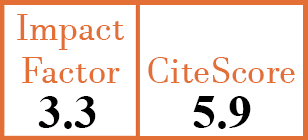Full Papers
Lung involvement in psoriatic arthritis patients: cross-sectional study on prevalence, clinical characteristics, and risk factors of a neglected comorbidity
B. Monosi1, I. Cristiano2, E. Capparelli3, A. Cito4, P. Conigliaro5, G. Lepri6, S. Guiducci7, E. Puxeddu8, P. Rogliani9, F. Iannone10, G. Lopalco11, M.S. Chimenti12
- Rheumatology, Allergology and Clinical Immunology, Department of Systems Medicine, University of Rome Tor Vergata, Rome, Italy.
- Rheumatology, Allergology and Clinical Immunology, Department of Systems Medicine, University of Rome Tor Vergata, Rome, Italy.
- Rheumatology, Allergology and Clinical Immunology, Department of Systems Medicine, University of Rome Tor Vergata, Rome, Italy.
- Department of Precision and Regenerative Medicine and Ionian Area (DiMePRe-J), University of Bari, Italy.
- Rheumatology, Allergology and Clinical Immunology, Department of Systems Medicine, University of Rome Tor Vergata, Rome, Italy.
- Division of Rheumatology, Department of Clinical and Experimental Medicine, University of Florence, Italy.
- Division of Rheumatology, Department of Clinical and Experimental Medicine, University of Florence, Italy.
- Unit of Respiratory Medicine, Department of Experimental Medicine, University of Rome Tor Vergata, Rome, Italy.
- Unit of Respiratory Medicine, Department of Experimental Medicine, University of Rome Tor Vergata, Rome, Italy.
- Department of Precision and Regenerative Medicine and Ionian Area (DiMePRe-J), University of Bari, Italy.
- Department of Precision and Regenerative Medicine and Ionian Area (DiMePRe-J), University of Bari, Italy.
- Rheumatology, Allergology and Clinical Immunology, Department of Systems Medicine, University of Rome Tor Vergata, Rome, Italy. maria.sole.chimenti@uniroma2.it
CER18557
2025 Vol.43, N°11
PI 1888, PF 1896
Full Papers
Free to view
(click on article PDF icon to read the article)
PMID: 40470557 [PubMed]
Received: 20/01/2025
Accepted : 05/05/2025
In Press: 30/05/2025
Published: 11/11/2025
Abstract
OBJECTIVES:
We aimed to assess lung involvement in patients with psoriatic arthritis (PsA), hypothesising that lung diseases (LDs) represent a distinct comorbidity of PsA and that the association between these two conditions is not merely coincidental.
METHODS:
Cross-sectional study of 322 patients with a diagnosis of PsA from three Italian centres. Each patient underwent a chest high-resolution CT prior to the start of a biological DMARDs. After pneumologists’ evaluation, patients were divided into three groups [chronic obstructive pulmonary disease (COPD), interstitial lung disease (ILD), and non-LD]. Univariate and multivariate statistical analysis were performed to analyse demographic and clinical characteristics of the total cohort and to compare disease characteristics between PsA patients with and without lung involvement.
RESULTS:
COPD was diagnosed in 39 patients (12.1%) and ILD in 27 patients (8.4%). The inflammatory burden [DAPSA>14 (OR 4.3, p.adj=0.03), swollen joint count (SJC)>3 (OR 3.2, p.adj=0.02), PASI>10 (OR 3.6, p.adj=0.008), BMI ≥30 (OR 3, p.adj=0.04)] emerged as the most important risk factor for COPD development in PsA patients. This association was weaker in patients with ILD and PsA, since just SJC emerged as a risk factor for ILD development [SJC>3 (OR 3, p.adj=0.04)]. Old age (≥65 years) increased the risk of COPD by up to 9.6 times (p.adj=0.004) and ILD by up to 7.6 times (p.adj=0.04).
CONCLUSIONS:
Our data support the hypothesis of a correlation between PsA and LDs highlighting that non-traditional risk factors may contribute to the development of LDs in PsA patients, especially in cases of uncontrolled, active articular disease.



